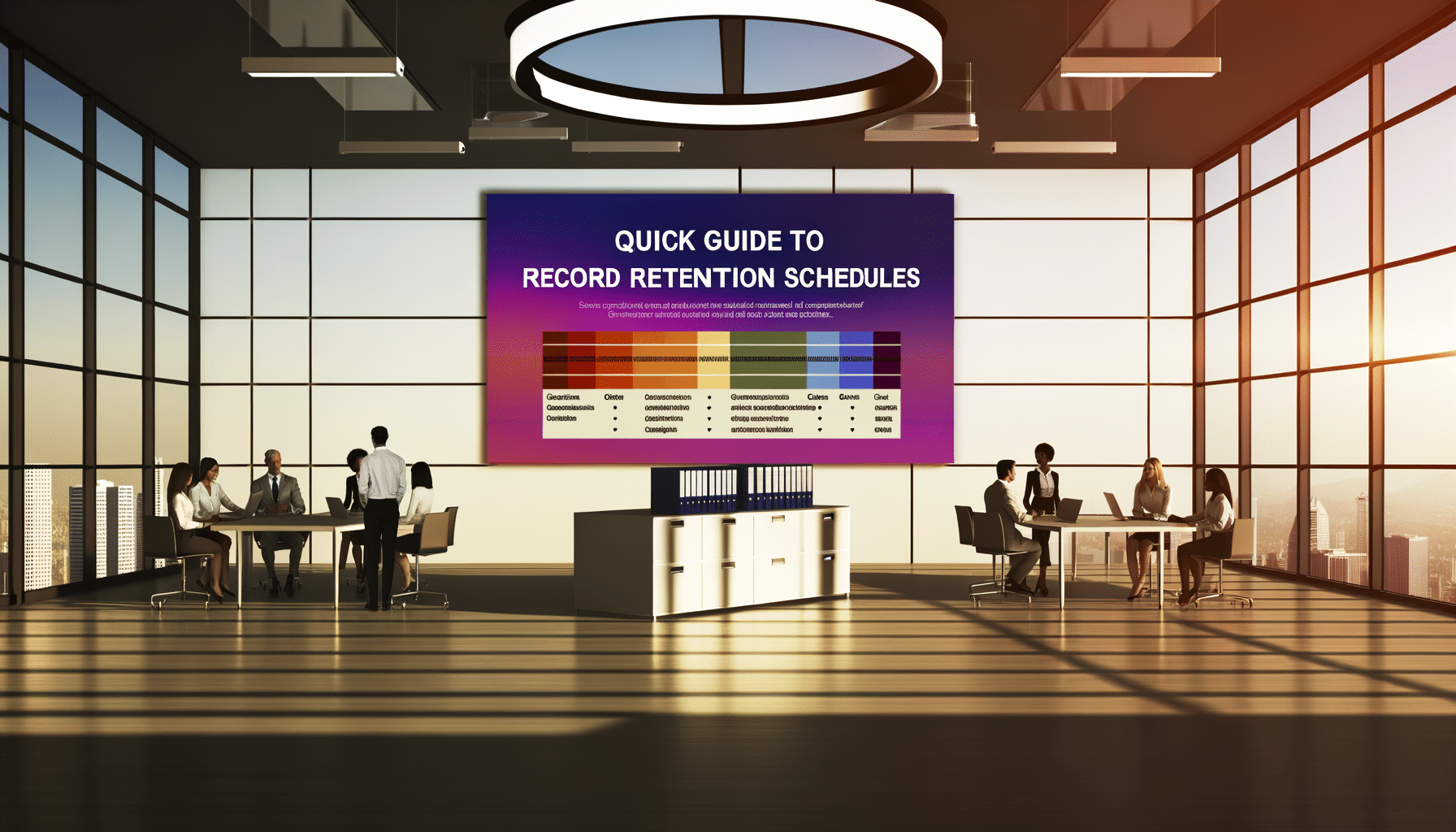- Blockchain Compliance
- November 17, 2024
Quick Guide to Record Retention Schedules

In the fast-paced world of business, compliance is more than just a word; it’s a mandate woven into the fabric of efficient operations. If you’ve ever felt overwhelmed by the maze of compliance regulations, you’re not alone. One crucial aspect of navigating this landscape is understanding ‘retention schedules.’ This blog aims to demystify retention schedules, making sure you never lose sight of compliance again.
Understanding Retention Schedules
Let’s start with the basics. What are retention schedules, and why should anyone care? Simply put, retention schedules are policy documents outlining how long an organization must keep certain records before disposal. These schedules are essential for maintaining compliance with industry and governmental regulations. They’re more than mere guidelines; they’re strategic tools that assist in the seamless management of data.
The Compliance Mandate
In the ever-evolving regulatory environment, staying compliant often feels like aiming at a moving target. Compliance isn’t static and varies significantly across industries and regions. For example, in healthcare, HIPAA regulations dictate specific data retention periods. Meanwhile, financial institutions must adhere to SOX regulations. The right retention schedule ensures you’re not only organized but also legally protected.
The Anatomy of a Retention Schedule
Personalizing a retention schedule requires a strategic understanding of the types of records your organization handles. Here’s what you need to know:
- Record Type: Identify the specific kinds of records you need to manage. These could range from contracts, financial records, and emails to employee files or customer data.
- Legal Requirements: Familiarize yourself with the legal or regulatory requirements that apply. What are the consequences of non-compliance?
- Retention Period: Determine how long each type of record must be kept before it can be lawfully destroyed.
- Disposal Protocol: Establish procedures for securely disposing of records once the retention period lapses.
- Reassessment Intervals: Set regular intervals to reassess the schedule as legal requirements and business needs evolve.
Real-World Considerations
A successful retention schedule requires collaboration across departments—legal, IT, HR, and compliance experts must work hand-in-glove. They’re the guardians of specific compliance criteria that ensure your retention policy is robust. An interconnected approach not only guarantees comprehensive coverage but also mitigates the risks associated with data breaches or legal complications.
Streamlining Retention with Technology
Technology can be your best ally when navigating the complexities of retention schedules. Tools like RecordsKeeper.AI can automate much of the legwork:
- AI-Powered Categorization: Automatically categorize and tag records, making them easily identifiable and retrievable.
- Compliance Automation: Seamlessly integrate compliance requirements into your retention schedules with automated workflow solutions.
- Secure Disposal: Automatically execute disposal protocols in compliance with legal standards, minimizing risks.
- Live Updates: Stay up-to-date with real-time alerts about changes in regulations that might affect your retention schedules.
Why Automation Matters
Gone are the days when manual record management sufficed. With data volumes exploding, automated solutions provide the efficiency and accuracy necessary for maintaining compliance. This transformation shifts record management from being a cumbersome task to a strategic advantage. It allows your team to focus on more critical aspects of your business.
Roadmap to a Compliant Future
Your journey towards compliance excellence doesn’t end with a stellar retention schedule. The regulatory landscape is in constant flux, making it imperative to adapt and evolve. Here’s how:
- Continuous Training: Empower your team with regular workshops and updated documentation on best practices.
- Periodic Audits: Conduct internal audits to ensure ongoing compliance with established retention policies.
- Feedback Loops: Create channels for feedback to continuously refine your retention strategies.
Conclusion
Embracing a systematic approach to record retention is no longer optional—it’s a business imperative. Whether you’re dealing with tax documents, employment records, or customer files, having an optimized retention schedule is indispensable for compliance success. As you move forward, remember: your compliance strategy is only as strong as the retention schedule backing it. For deeper insights and cutting-edge solutions, continue to stay connected with me as I navigate the ever-dynamic entrepreneurial and compliance landscape.
After all, compliance isn’t just about ticking boxes; it’s about empowering your business to thrive in a regulated world.
Toshendra Sharma is the visionary founder and CEO of RecordsKeeper.AI, spearheading the fusion of AI and blockchain to redefine enterprise record management. With a groundbreaking approach to solving complex business challenges, Toshendra combines deep expertise in blockchain and artificial intelligence with an acute understanding of enterprise compliance and security needs.
Related Posts

Organizing External Auditor Access
Setting up secure access for external auditors.
- December 22, 2024
Tracking Record Access During Audits
Maintaining clear logs of who accessed what during audits.
- November 22, 2024
Archives
- December 2024
- November 2024
- October 2024
- September 2024
- August 2024
- July 2024
- June 2024
- May 2024
- April 2024
- March 2024
- February 2024
- January 2024
- December 2023
- November 2023
- October 2023
- September 2023
- August 2023
- July 2023
- June 2023
- May 2023
- April 2023
- March 2023
- February 2023
- January 2023
- December 2022
- November 2022
- October 2022
- September 2022
- March 2019
Want to get more content like this?
Signup to directly get this type of content to your inbox!!
Latest Post
Organizing External Auditor Access
- December 22, 2024
Document Control in Manufacturing Plants
- December 21, 2024
Handling Rush Financial Report Requests
- December 20, 2024
Managing Record Access After Staff Changes
- December 19, 2024





